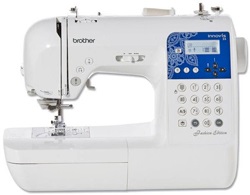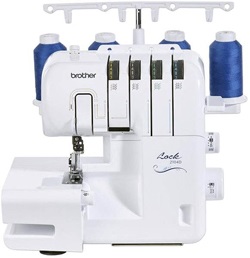How to Choose Sewing and Embroidery Machines
Selecting a suitable sewing machine is not easy. There are a huge number of manual and electronic sewing machines with a wide range of features and uses on the market. You could also choose embroidery machines to help you decorate your clothing with beautiful and unique patterns. Which programmes must you definitely have on a new machine? What about alternatives such as an overlocker or a cutting machine? We'll try to answer all your questions so that you can choose the right sewing machine for you and your family.

Several Tips for Choosing A Sewing or Embroidery Machine
- Think about what fabric you will work with.
Electronic sewing machines are easier to use, and they also save time.
- Machines for professional use have a more robust construction, but cost more money.
- Select the machine by program type, not by number.
- Think about whether you want to only sew or sew and embroider. Choose a machine accordingly.
Basic Parameters for Selecting Sewing and Embroidery Machines
Mechanical / Electronic Sewing Machines
The manual sewing machine is suitable for those who have experience with old-fashioned manual settings and controls and who would prefer to stick with what they know. Manual sewing machines are generally cheaper.
If you want more convenience and to save time rather than money, then an electronic automatic sewing machine will be a better choice for you. Automatic sewing, needle positioning and other clever features will make sewing much easier for you. When compared to manual sewing machines, electronic sewing machines are also quieter and easier to operate. You won't even have to worry about thread tension on the modern machine. The electronic sewing machine will automatically help with most things. It may also have a digital display of stitches to choose from, mirror-imaging and automatic stitch selection according to the speed and tension you are working.
Programmes
When choosing a sewing machine, focus on the type of programmes offered. Do not be seduced by the amount. More is not necessarily better. Concentrate on the different types of programmes and features.
If you plan to purchase a cheaper sewing machine, choose one that has the basic functions of different lengths of stitches, basic overlocking and one which is able to sew buttonholes (either automatically or semi-automatically, in 4 steps).
With more expensive sewing machines, basic features such as an overlock stitch and buttonhole sewing are a matter of course. It's worth paying attention to alphabet sewing and various types of stitches. The number and types of stitches determine the sewing machine's variability and allow you to creatively decorate your creations. The width of decorative stitches ranges from 5mm to 40mm on the more expensive sewing machines. If you are a beginner, it pays to think of the future. Once you learn to sew, you will enjoy a wide selection of programmes and a great variety of stitch width settings.
Classic Sewing Machine / Overlocker
Many classic sewing machines are equipped with an overlock stitch that is used to seam and stitch the elastic fabric in one step. However, compared to a professional overlocker that sews with up to 4 threads, the sewing machine uses only 2 threads, thus never completely replacing the 4-thread overlocker.
Overlockers will overcast and seam with 2, 3 or 4 threads to create truly professional looking clothing. It not only sews the fabric, but also trims the raw edges automatically. It cannot replace a conventional sewing machine though. It cannot sew standard stiches like a regular sewing mahine.
So how do you decide which machine to choose? We recommend buying a classic sewing machine with an overlock stitch and over time when you become more experienced, you can also buy an overlocker for more complicated designs and materials.
Automatic Thread Cutters
Automatic thread cutting is one of the most useful sewing and embroidery features. The machine automatically pulls both threads to the back of the cloth and automatically cuts it off about 2 cm. This saves you time searching for scissors, stretching the thread and then cutting it.
When choosing the machine, pay attention to the difference between thread trimming and the automatic thread cutting. There are two different things:
Embroidery Machine
There are two types of embroidery machines on the market:
Combined embroidery machines are typically a third more expensive than a separate sewing or embroidery machine. So if you only embroider occasionally, it will be more economical to pay for a combination of a sewing and an embroidery machine.
Key Parameters for Selecting a Sewing Machine
We have created an overview of the parameters and features to focus on when choosing a machine for beginners, for experienced sewers and for professionals so that you can know exactly what to look out for.
For beginners and home use
Have you just started sewing or do you rarely use the sewing machine? Do you need to cut pants, sew patches or put in a seam? Then you will need a versatile sewing machine that can stitch thin, elastic materials, as well as tough materials, like jeans. It is important that the machine is easy to operate and that all operations on it are as simple as possible. So, when selecting a sewing machine, choose:
For more advanced, creative sewers
Do you enjoy sewing and would you like to make your own clothes? Then you will need the following:
For professionals
Sewing machines for professional sewers and workshops must be able to withstand demanding operations. The quality of processing comes first. Choose sewing machines with the following parameters:
Are you a beginner, do you sew regularly, or do you make a living with sewing? In our offer of sewing machines, everyone will find the machine that suits them. Just choose from a range of programmes and features you'll need to sew for a hobby or as a profession. We offer mechanical models of sewing machines at low prices as well as silent electronic sewing machines with the overlock stitch and many additional features and programmes. Make yourself and your loved ones happy and get them a home sewing machine which can deal with every embarrassing hole, tight skirt or patch.
An overlocker gives you the type of quality sewing you know from professionally stitched clothing you buy from stores. These special sewing machines not only sew, but also seam and cut. They are useful for making t-shirts, dresses, tracksuits and lots of other clothing, both for children and adults. They cannot however replace the conventional sewing machine.
Frequently Asked Questions When Choosing an Overlocker
What is the difference between an overlocker and a sewing machine with an overlock stitch?
An overlocker is a professional sewing machine which can handle many types of fabrics. It is equipped with two to five threads and it can overcast, seam and trim raw edges at the same time. It saves you work and time. When you use an overclocker, your seams look more professional.
A sewing machine equipped with an overlock stitch is only able to sew with two threads on the overlock. That's why you'll never get the same quality of sewing as with an overlocker. However, if you are only stitching basic materials, a sewing machine with a two thread overlock stitch should be sufficient.

Are you thinking about how to revive the clothes you love or spruce up something new? Try out embroidering your t-shirt or skirt. An embroidery machine will help you copy any print. When compared to prints that are ironed on, embroidery prints have an extraordinarily long life and form a beautiful design accessory for clothing. Are you bored with ready-made garments? Decorate them with flowers, inscriptions, or children's cartoons. If you have a small family business, you could embroider your own logo on the front of shirts or t-shirts. You could buy a specialised embroidery machine or buy a combination of a sewing and an embroidery machine in one.

Fabric Cutting Machines
People who love patchworking will appreciate a cutter that can not only cut fabric into small pieces of any shape, but also cuts leather, vinyl foil, felt and other materials. You can therefore use a cutting machine for preparing sewing materials, but also for cutting vinyl stickers and scrapbooking material. Some cutting machines allow you to design or copy images from the internet in addition to the cutting function. You can just replace the blade with a pen and draw any shape. You then scan the image to create a template for cutting.
Sewing machines and overlockers are usually not sold with sets of needles and threads or with covers to store or travel. We have various sets of standard and special equipment that will be useful for you in the future. Add a selection of sewing threads and a travelling bag to your new machine.
Glossary - Sewing and Embroidery Machines
Automatic needle threader
An automatic needle threader is a sewing machine appliance that helps you put the thread into a needle. You can thread the needle in an instant and start sewing immediately.
Free arm
The free arm or space around the needle and foot should be minimal or adjustable to make it easier to sew sleeves or legs on a narrow arm.
Overlock stitch
The overlock stitch seams and stitches the cloth in one step. It is suitable for sewing especially flexible materials. The classic sewing machine sews the overlock stitch with two threads, while the overlocker has four or more threads.
Horizontal Rotary Grab (drop-in)
The bottom bobbin case is positioned horizontally with a stitch plate and has a mostly transparent plastic cover for checking the amount of thread on the bobbin. The advantage of the horizontal rotary teeth is a mostly silent operation, the possibility of sewing at higher speeds and a greater variety of stitches.
Dictionary of Terms


